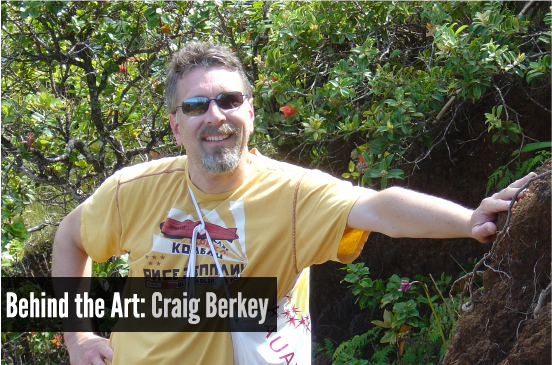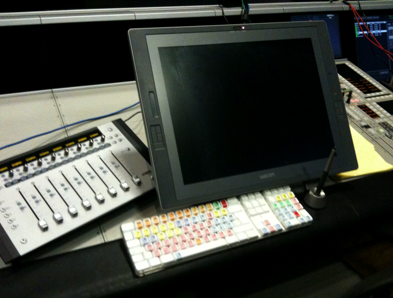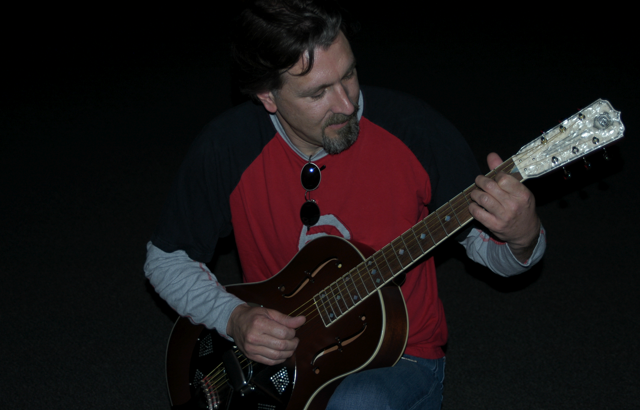
It’s time for another “Behind the Art” interview, the section of Designing Sound created with the goal of studying the artistic and creative aspects of sound design. We’ve asked one of the most prolific sound designers right now, Craig Berkey, to share some thoughts with us.
Just recently, Berkey has been the sound designer for both the latest mutant magnum opus, X-Men: First Class, and Terrence Malick’s poetic The Tree of Life, winner of this year’s Palme d’Or in Cannes. Two very, very different movies which just goes to show the diversity of Berkey’s impressive career. Berkey has been in charge of the sound department on blockbusters like I, Robot and Superman Returns but has also collaborated closely with sound supervisor Skip Lievsay on the four recent films by the Coen brothers, including No Country for Old Men and True Grit – which resulted in Berkey receiving three well-deserved Academy Award nominations, two for mixing and one for editing.
The Vancouver-based Berkey shares thoughts on music, philosophy and experimentation – and how the net has helped his creative process.
Designing Sound: Could you describe your sound design philosophy? What’s sound design for you?
Craig Berkey: Sound design for me, in the world of film, is the overall thought/concept and execution of the entire sound-track. Philosophically my role as a sound designer is to help filmmakers achieve and exceed their aural aspirations for their films. I approach this with an ears wide-open attitude. I like to get a feel for the film I’m working on, not by me deciding what I think it should sound like, but by letting the images and sounds present at the time of my initial viewing soak in. This experience, in conjunction with discussions with the filmmakers, helps me discover any unturned stones the sound team can work towards revealing. If I am not open to original ideas at the start and forge ahead with the soundtrack, it can be nothing more than previously expressed concepts, perhaps with different execution.
 DS: How has this philosophy and approach to your work changed through the evolution of your career?
DS: How has this philosophy and approach to your work changed through the evolution of your career?
CB: As I have grown in my career and learned more about the effect that sound can have on the viewer, I’ve learned to disregard my initial reactions to instead explore new ideas. Basically I’ve been trying to unlearn everything I’ve learned along the way as early on we are taught to approach sound in a more predictable manner. This doesn’t always work out but sometimes you get to a place that you never would have otherwise. This approach can be like photography where you may take one hundred photographs and have only two or three worth keeping. At the beginning of my career I was frustrated at the lack of a creative vision around the soundtrack. This was the result of having many sounds from various departments appear at the final mix each feeling independent, missing a sense of wholeness. These results were inevitable as traditionally most of the people would have worked on these elements in isolation and when they arrived on the stage it would be the first time everyone had heard their materials together. Sometimes this approach would work out however typically we could only get to the point where everything was covered and nothing was too loud leaving no room for new ideas or time to explore. With this in mind, I started to take the approach of pulling sounds together early in the process and make some decisions around what to lose and what to keep before the final mix. I felt this worked better but at times may have gone too far and tried to control the process too much. Now I try to combine the two styles of working by still trying to find a creative direction early but still leave room for experimentation.
DS: How do you like to start a project? Do you start building a sound map from the script, storyboard or any early description of the project?
CB: Ultimately I am looking to define a method to help the filmmakers and sound team work together during the editorial process to integrate sound and picture early on. I like to start a project by determining what the narrative is “really” about; this is where the ears wide-open part comes in. It’s really all about understanding the Filmmaker’s vision. We’re there to bring their vision to life and if we don’t fully understand it then we won’t be successful. Every situation is different, sometimes I can gather lots of information through the script, other times watching the filmmakers previous films or sometimes just through in-depth discussions around themes, character arcs, etc.
DS: How much experimentation is present in your sound design process?
CB: The more I do this work, the more I try to move away from known concepts. A simple example would be when I bring a sound onto the Pro Tools timeline I tend to drag and drop it somewhere near where I think I might want it and play it as opposed to the exact spot one would expect. It may be completely wrong in that position, but once in a while something magical happens that sparks an unexpected idea and result. Another idea would be to take several random sounds and place them on adjacent tracks and play them all together and see what happens. The key is to be open to new ways of working at all times so that I don’t get stuck into one specific approach but rather keep my mind open to experimentation.
DS: How do you prefer to work with directors? You have a very tight collaboration with a handful of directors, Terrence Malick, The Coens, Joe Wright – they all seem to be very different personalities, though.
CB: I have been very fortunate to work with an amazing array of highly creative and talented directors that value the critical role sound plays in the filmmaking process. It is my goal to create a unique sound signature for each film I am involved in. To do this, I prefer to work over a long period of time as opposed to the more traditional approach of doing all of the editing in the last few months of post production. Having enough time to get into a filmmaker’s head and experiment with multiple ideas is optimal. This approach gives us the time to reflect on approaches taken, and provides us with the ability to iterate and elevate a soundtrack. Every director has a different style. Joe has a rhythmic/musical bent, The Coens a precise sparseness to their direction and Terry with his separation of image and sound is each served best by a longer term sound development period. For me this also includes the mix. Having existing relationships with filmmakers dispenses with the “getting to know you” period and allows us to spend our time focused on the film.
DS: You spent two years on and off working on The Tree of Life. How do you maintain inspiration and creativity during such a long process?
CB: The entire experience was creative throughout thanks to Terry who is a highly inspirational visionary. Terry didn’t want me to watch the complete film for quite a while, he was more interested in discovering ways to use sound in the smaller sections to help us feel something different than what the image may be telling us. Initially he had me create sounds based on his verbal descriptions without any imagery. He then followed up with targeted sections of film for me to design to but they were in black and white. As the film progressed, he then sent full black and white reels for me to respond to. Eventually we got to the point of viewing the whole film, which led to further explorations of using sound to relate sections together. For example, the backgrounds used in the forest in the “natural history” section are the same as in the forest where young Jack and his brother are shooting the BB gun. When I’m mixing with Terry he directs me as he would one of his actors. “Craig, imagine you’re a drunken baby, take those whispered lines and weave them around”. How could that not be something that keeps you creative?
DS: What are your biggest influences? Which are your favorite films for sound?
CB: Growing up I rarely went to the movies but I do remember seeing Barton Fink and hearing the desk bell ring endlessly over several strange cuts of the lobby. It moved me and inspired me to follow a path in sound. Little did I know that years later I’d get the opportunity to work with Skip Lievsay and that he would become an amazing collaborative partner and inspirational force in my career.

DS: Do you have any kind of musical background? Your work in films like No Country for Old Men, The Tree of Life and The Soloist has been extremely musical – do you collaborate closely with the composer?
CB: I am a musician at heart. I have played guitar for almost forty years. When I graduated from high school I worked as a classical guitar teacher while also playing in a rock band at night. During this time I played about four hours a day. I believe this immersive experience influenced my work profoundly. I much prefer to have sounds play in some kind of rhythmic relationship as opposed to being just in sync with picture.
Whenever possible I prefer to collaborate closely with the composer. However because of everyone’s demanding schedules it rarely works out that way. At the very least, because of my preferred work method of having mixes done early and integrating the sounds into the editor’s tracks throughout the editorial process, the composer can hear what we are up to by working with actual materials and building upon them.
DS: Quite often, you’re working as both sound designer and re-recording mixer. What does this mean for the way you work?
CB: I can’t really delineate between the two it is all interconnected in my mind. How can I know if the sounds that I am working on are appropriate if they are not mixed? How can I mix without sounds that I think will work in the film? I mix as I edit. As a sound ends up in the timeline volume, eq, panning and reverb etc. are addressed. After I finish a section I’ll go back and tweak and try different things. I used to cut the start and end of sounds in sync with picture, but now I generally toss it in there and grab the fader and mix it in and see what inspires me. On a surface level, the session doesn’t end up “looking” very good. There are sounds all over the place that look like they cut on and off but if you look at the volume graph and hear the result you’ll see what’s happening.
 DS: You live in Canada but mix in several different places – LA, NYC, London. Does this influence your approach to sound design in general?
DS: You live in Canada but mix in several different places – LA, NYC, London. Does this influence your approach to sound design in general?
CB: The internet is a great thing. I am very lucky that I can work in my home studio and travel to mix projects. This has an effect on my approach in that I have to be very self contained. I have to be able to easily take my mix anywhere in the world, set it up quickly and have it translate. I travel with my drive, iLok and Wacom Cintiq. Although I’ve mixed on several different consoles, I discovered a while ago that because of the way I work I don’t really need a traditional console for the final mix. Instead of having to get used to a new setup for each final I have started bringing my setup with me. When we mixed Hanna in London, the engineers at Pinewood asked me how I would like the System 5 setup. I kindly asked them to take it out a put a flat surface in its place, after they stopped laughing they said “really”. They removed the System 5 and it worked out great as I could work with gear I was comfortable with which is best for the film. We had a D-Command for dialogue as well as the System 5 for music. One thing to keep in mind is that this approach only works if the filmmakers have heard and tweaked the mix up until the point of the final mix.
DS: Finally, what would be your advice to any sound designer who wants to find/enhance his artistic vision and personal creative approach?
CB: The most important thing is to listen…. Listen to films, listen to your peers, listen to your instincts, listen to music, listen to nature……
Great and inspiring article on one of the great sound designers out there! Thanks Craig, Peter and the guys at DS!
Very inspiring, thank you!!
I have never tried using a Wacom board, but I imagine it being very handy for fx drawing automation curves or are there other ways in which it excels over a mouse? Great interview, very inspiring!
Well,huge input for profesional sound guys.thank CB
Craig,
Thanks for sharing your experience as well as thoughts about sound designing !! I was in bit of doubt about am i thinking in a right direction while working as a sound designer .. But thanks to you .. You have inspired me .. Cheers !!!